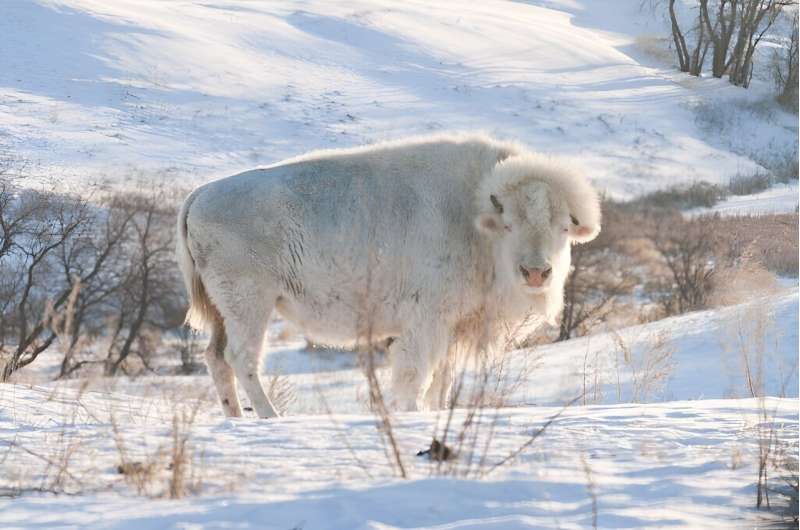This article has been reviewed according to Science X's editorial process and policies. Editors have highlighted the following attributes while ensuring the content's credibility:
fact-checked
peer-reviewed publication
trusted source
proofread
Researchers develop comprehensive genetic map for bison, discover gene responsible for albinism

A research team led by scientists from the Texas A&M School of Veterinary Medicine & Biomedical Sciences (VMBS) has developed the most comprehensive genome yet for the North American bison, bringing the animal's genetic roadmap up to date with the latest genome sequencing technology. In doing so, the research team also discovered the gene responsible for albinism in bison.
The study—recently published in G3: Genes, Genomes, Genetics—details the development of this high-resolution reference genome, which the researchers then used to produce the first test for genetic mutations, starting with the mutation responsible for albinism.
Albinism, a rare condition characterized by a lack of pigment in an animal's body, making them look white with red eyes, has historical significance in that albino bison have been recognized as a religious symbol for some Native American Indigenous tribes.
The study also lays the framework for determining other genetic variations that impact important bison traits, such as those that contribute to the health and production value of this species.
Dr. James Derr, a VMBS professor of veterinary pathobiology and genetics who led the research team that created the first bison genome back in 2015, assembled the team that developed this new reference genome. This team includes assistant professor of genetics Dr. Brian Davis, graduate student Sam Stroupe, and representatives from Texas Parks and Wildlife and the National Park Service.
"Because reference genomes can help researchers identify and characterize genes that are responsible for a large number of traits, this technology is used to do all kinds of things, including diagnosing health conditions and developing targeted treatments," Davis said.
The newest bison reference genome was developed using technology that allows researchers to create genomes based on DNA from hybrids, which are animals with DNA from two different species. In this case, the researchers used DNA from a type of bison-cow hybrid called an F1, or individuals with a perfect 50-50 split between its parents' DNA.
In general, F1 hybrids between bison and cattle are rare but have historically happened, since we now know that most bison herds in North America contain descendants of hybrids between bison and cattle—a discovery that Derr and his research partners made last year.
"One day we got a call from Texas Parks and Wildlife saying they knew someone who had an F1 hybrid," Derr said. "It was the first fully documented, first-generation F1 hybrid I have seen in 25 years of working with bison. That's why we were able to do this."
To create the new bison genome, the researchers first sequenced the genome of the F1 hybrid as well as the bison mom and the domestic cattle father. With this information, they were able to separate bison DNA from the cattle DNA regions in the hybrid.
Since the cattle genome is already very advanced, it provided a reference for creating the new bison genome, helping to guide researchers in developing the complete high-resolution reference bison genome.
To prove the utility of the new genome, the team set out to discover which gene mutation was responsible for albinism in bison and to create a genetic test that could be used to identify carriers of that mutation.
The discovery is the first time anyone has successfully determined the gene mutation responsible for an observable trait in bison.
"We knew albinism was an inherited recessive trait, but we didn't know which gene was responsible," Stroupe said. "So, we sequenced the DNA from a few albino bison and compared them to those of normal coloration to find the mutation that causes albinism. As it turns out, the mutation causes an important enzyme to cease functioning correctly, which leads to the lack of skin pigmentation."
The uniqueness of albino bison
Many North American Indigenous peoples regard white bison as sacred entities with prophetic spiritual associations. While not all white bison have albinism, the birth of one is cause for celebration in some communities.
Despite this cultural significance, Derr isn't suggesting that people try to produce albino bison using genetic testing.
"Sadly, albino bison are often not very healthy," Derr said. "They tend to develop skin cancers, and they can develop other health problems as they age."
Albino bison are also different from white or tan bison that result from crossing bison with white cattle, particularly Charolais. These bison lack the red eyes and pink nose of true albinos.
Now that a more accurate bison genome exists, scientists can learn more about the genetic makeup of North America's bison population.
"The development of this new reference genome and the identification of a causative genetic mutation is exciting news for bison," Derr said. "It opens the doors for new discoveries and insights into bison genetics.
"Overall, this is a vital step toward the future conservation management of the United States' national mammal," he said.
More information: Sam Stroupe et al, Chromosome-level reference genome for North American bison (Bison bison) and variant database aids in identifying albino mutation, G3: Genes, Genomes, Genetics (2023). DOI: 10.1093/g3journal/jkad156
Journal information: G3 Genes|Genomes|Genetics
Provided by Texas A&M University





















